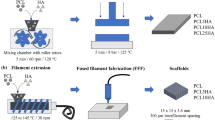Abstract
For tissue engineering and regeneration, a porous scaffold with interconnected networks is needed to guide cell attachment and growth/ingrowth in three-dimensional (3D) structure. Using a rapid prototyping (RP) technique, we designed and fabricated 3D plotting system and three types of scaffolds: those from polycaprolactone (PCL), those from PCL and hydroxyapatite (HA), and those from PCL/HA and with a shifted pattern structure (PCL/HA/SP scaffold). Shifted pattern structure was fabricated to increase the cell attachment/adhesion. The PCL/HA/SP scaffold had a lower compressive modulus than PCL and PCL/HA scaffold. However, it has a better cell attachment than the scaffolds without a shifted pattern. MTT assay and alkaline phosphatase activity results for the PCL/HA/SP scaffolds were significantly enhanced compared to the results for the PCL and PCL/HA scaffolds. According to their degree of cell proliferation/differentiation, the scaffolds were in the following order: PCL/HA/SP > PCL/HA > PCL. These 3D scaffolds will be applicable for tissue engineering based on unique plotting system.









Similar content being viewed by others
References
Hutmacher DW, Schantz T, Zein I, Ng KW, Teoh SH, Tan KC (2001) Mechanical properties and cell cultural response of polycaprolactone scaffolds designed and fabricated via fused deposition modeling. J Biomed Mater Res A 55:203–216
Woodfield TBF, Malda J, De Wijn J, Péters F, Riesle J, Van Blitterswijk CA (2004) Design of porous scaffolds for cartilage tissue engineering using a three-dimensional fiber-deposition technique. Biomaterials 25:4149–4161
Sachlos E, Czernuszka JT (2003) Making tissue engineering scaffolds work. Review on the application of solid freeform fabrication technology to the production of tissue engineering scaffolds. Eur Cells Mater 5:29–40
Hollister SJ (2005) Porous scaffold design for tissue engineering. Nat Mater 4:518–524
Williams JM, Adewunmi A, Schek RM, Flanagan CL, Krebsbach PH, Feinberg SE, Hollister SJ, Das S (2005) Bone tissue engineering using polycaprolactone scaffolds fabricated via selective laser sintering. Biomaterials 26:4817–4827
Mironov V, Boland T, Trusk T, Forgacs G, Markwald RR (2003) Organ printing: computer-aided jet-based 3D tissue engineering. Trends Biotechnol 22:157–161
Seitz H, Rieder W, Irsen S, Leukers B, Tille C (2005) Three-dimensional printing of porous ceramic scaffolds for bone tissue engineering. J Biomed Mater Res B 74b:782–788
Hutmacher DW, Sittinger M, Risbud MV (2004) Scaffold-based tissue engineering: rationale for computer-aided design and solid free-form fabrication systems. Trends Biotechnol 22:354–362
Khalil S, Nam J, Sun W (2005) Multi-nozzle deposition for construction of 3D biopolymer tissue scaffolds. Rapid Prototyping J 11:9–17
Sun W, Darling A, Starly B, Nam J (2004) Computer-aided tissue engineering: overview, scope and challenges. Biotechnol Appl Biochem 39:29–47
Sun W, Lal P (2002) Recent development on computer aided tissue engineering: a review. Comput Methods Programs Biomed 67:85–103
Hutmacher DW (2000) Scaffolds in tissue engineering bone and cartilage. Biomaterials 21:2529–2543
Pfister A, Landers R, Laib A, Hübner U, Schmelzeisen R, Mülhaupt R (2004) Biofunctional rapid prototyping for tissue-1 engineering applications: 3D bioplotting versus 3D printing. J Polym Sci Pol Chem 42:624–638
Lee M, Dunn JCY, Wu BM (2005) Scaffold fabrication by indirect three dimensional printing. Biomaterials 26:4281–4289
Vozzi G, Flaim C, Ahluwalia A, Bhatia S (2003) Fabrication of PLGA scaffolds using soft lithography and microsyringe deposition. Biomaterials 24:2533–2540
Zein I, Hutmacher DW, Tan KC, Teoh SH (2002) Fused deposition modeling of novel scaffold architectures for tissue engineering applications. Biomaterials 23:1169–1185
Landers R, Hübner U, Schmelzeisen R, Mülhaupt R (2002) Rapid prototyping of scaffolds derived from thermoreversible hydrogels and tailored for applications in tissue engineering. Biomaterials 23:4437–4447
Hoque ME, Hutmacher DW, Feng W, Li S, Huang MH, Vert M, Wong YS (2005) Fabrication using a rapid prototyping system and in vitro characterization of PEG–PCL–PLA scaffolds for tissue engineering. J Biomater Sci 16:1595–1610
Wang X, Yan Y, Zhang R (2007) Rapid prototyping as a tool for manufacturing bioartificial livers. Trends Biotechnol 25:505–513
Schantz JT, Brandwood A, Hutmacher DW, Khor HL, Bittner K (2005) Osteogenic differentiation of mesenchymal progenitor cells in computer designed fibrin–polymer–ceramic scaffolds manufactured by fused deposition modeling. J Mater Sci 16:807–819
Partee B, Hollister SJ, Das S (2006) Selective laser sintering process optimization for layered manufacturing of CAPA® 6510 polycaprolactone bone tissue engineering scaffolds. J Manuf Sci Eng 128:531–540
Lee JH, Park SA, Park KE, Kim JH, Kim KS, Lee JH, Kim WD (2010) Fabrication and characterization of 3D scaffold using 3D plotting system. Chin Sci Bull 55:94–98
Author information
Authors and Affiliations
Corresponding author
Rights and permissions
About this article
Cite this article
Park, S.A., Lee, S.H. & Kim, W.D. Fabrication of porous polycaprolactone/hydroxyapatite (PCL/HA) blend scaffolds using a 3D plotting system for bone tissue engineering. Bioprocess Biosyst Eng 34, 505–513 (2011). https://doi.org/10.1007/s00449-010-0499-2
Received:
Accepted:
Published:
Issue Date:
DOI: https://doi.org/10.1007/s00449-010-0499-2




